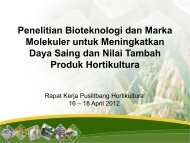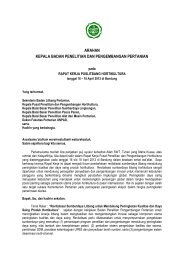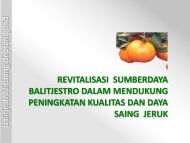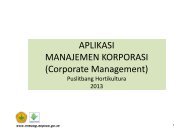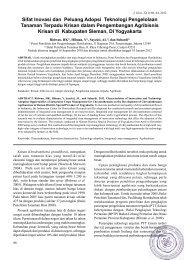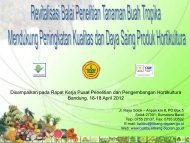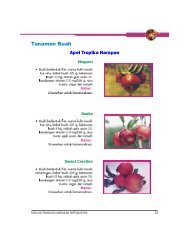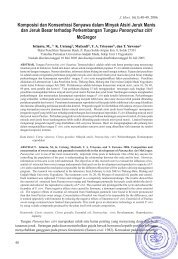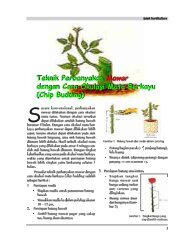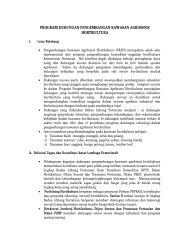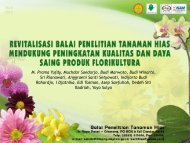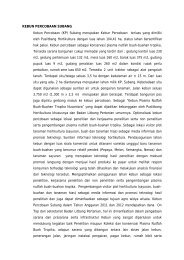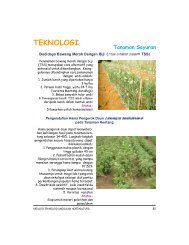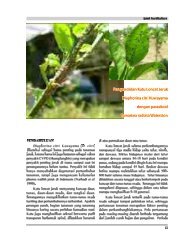SEMNAS Hortikultura Buku 2 - Departemen Pertanian
SEMNAS Hortikultura Buku 2 - Departemen Pertanian
SEMNAS Hortikultura Buku 2 - Departemen Pertanian
You also want an ePaper? Increase the reach of your titles
YUMPU automatically turns print PDFs into web optimized ePapers that Google loves.
Control of Moler Disease (Fusarium oxysporum f.sp. cepae) on Shallot Using Trichoderma sp. and Gliocladium sp.<br />
Pustika, A B, Iswadi, A, Fibrianty, and Sutarno<br />
Control of Moler Disease (Fusarium oxysporum f.sp. cepae) on Shallot Using<br />
Trichoderma sp. and Gliocladium sp.<br />
Pustika, A B, Iswadi, A, Fibrianty, and Sutarno<br />
Assessment Institute of Agricultural Technology of Yogyakarta (BPTP Yogyakarta), Karangsari, Wedomartani,<br />
Ngemplak, Sleman, Yogyakarta Special Province<br />
ABSTRACT. Moler disease in shallot caused by Fusarium oxysporum f.sp. cepae becomes dominant pathogen<br />
in the shallot development area, in Yogyakarta Special Province, both in coastal area of Kulonprogo Regency<br />
and in dry agro ecosystem of Selopamioro District of Bantul Regency. Application of fungicides which is very<br />
intensive and absolutely higher than the recommended dosage implies serious risk. For this reason, alternative<br />
fungicidal materials that environmentally friendly are being intensively observed at field experiment level. In<br />
this assessment, the results regarding the effect of antagonist fungi (Trichoderma sp. and Gliocladium sp.),<br />
compare to lime application and chemical control, against moler disease was conducted. Randomized<br />
Completely Block was used to design the experiment plot which was consisted of ten treatments and three<br />
replications in coastal area of Kulonprogo Regency. The antagonist fungi were mixed with organic fertilizer for<br />
spreading thoroughly to the soil. Lime also was applied to the soil, while chemical fungicides were sprayed to<br />
the plants. The result showed that percentage of moler disease with difenokonazol and propineb (chemical<br />
pesticides) treatment was significantly higher, 6.24% and 6.35% at 28 days after planting; and 7.94% and 7.72%<br />
at 42 days after planting, respectively, compare to other treatments (antagonist fungi and lime). At 42 days after<br />
planting, Gliocladium sp. which was applied at planting only, gave the best result in control moler symptom<br />
(4.02%). With antagonist fungi treatment, shallot production gained 26.19 ton/ha. Whilst in Bantul Regency, t-<br />
test with fifteen replications on Moler Survey was used to compare moler percentage between shallot area with<br />
Trichoderma sp. and shallot area without Trichoderma sp. In shallot area with Trichoderma sp. treatments,<br />
moler percentage was 6.094% lower than area without Trichoderma sp. treatments.<br />
Keywords: Shalot, moler disease, Trichoderma spp.,and Gliocladium spp.<br />
Moler disease caused by Fusarium ocysporum f.sp. cepae is become one of dominant disease<br />
on shallot in Yogyakarta Special Province, both in shallot development area at coastal area of<br />
Kulonprogo Regency and in dry agro ecosystem area at Selopamioro of Bantul Regency. F.<br />
oxysporum f.sp. cepae is soilborne disease. The infected plants shows symptom such as stunt growth,<br />
yellowing, twisted and horizontal growth of leaves (Wiyatiningsih, 2002).<br />
Currently, problems encountered, such as development of pathogen resistance to fungicides,<br />
inability of seed-treated fungicides to protect the roots of mature plants, rapid degradation of the<br />
chemicals, and a requirement for repeated applications were occurred caused by the use of<br />
environmentally hazardous fungicidal treatment of seed, seedlings, or soils is still the most widely<br />
used control measure for suppressing soilborne diseases. One approach to address this problem is the<br />
use of naturally and environmentally safe biological control microorganisms, used alone or in<br />
conjunction with integrated pest management (IPM) strategies (Hebbar and Lumsden, 1999).<br />
Biopesticides, including biofungicides, bio-insecticides, and bioherbicides are receiving<br />
increased exposure in scientific annals as alternatives to chemical pesticides and as key components of<br />
IPM systems. Biofungicides for controlling seedling and soil-borne diseases, such as Pythium sp.,<br />
Fusarium sp., Rhizoctonia sp, and Verticillium sp., have received increasing attention in recent years,<br />
primarily as nontoxic and non residue producing control agents (Menn and Hall, 1999).<br />
Biological control agent which is developed commercially is Gliocladium sp. and<br />
Trichoderma sp. The fungi proliferate as asexual conidia that are held in masses of moist spores. They<br />
survive as vegetative segments of mycelium, termed chlamydospores, usually embedded in organic<br />
matter. The spores are not airborne and are dispersed only as spore suspensions in water, or carried in<br />
soil or in organic debris. They produce several antibiotic metabolites that are thought to enhance it soil<br />
competitiveness. The metabolite most likely associated with control pathogen is gliotoxin, an<br />
epipolythiopiperazine-3,6-dione antibiotic and chitinase (Aluko and Hering, 1970 and Gillespie and<br />
Prosiding SeminarNasional Pekan Inovasi Teknologi <strong>Hortikultura</strong> Nasional: Penerapan Inovasi Teknologi <strong>Hortikultura</strong><br />
dalam Mendukung Pembangunan <strong>Hortikultura</strong> yang Berdaya Saing dan Berbasis Sumberdaya Genetik Lokal,<br />
Lembang, 5 Juli 2012<br />
│275



